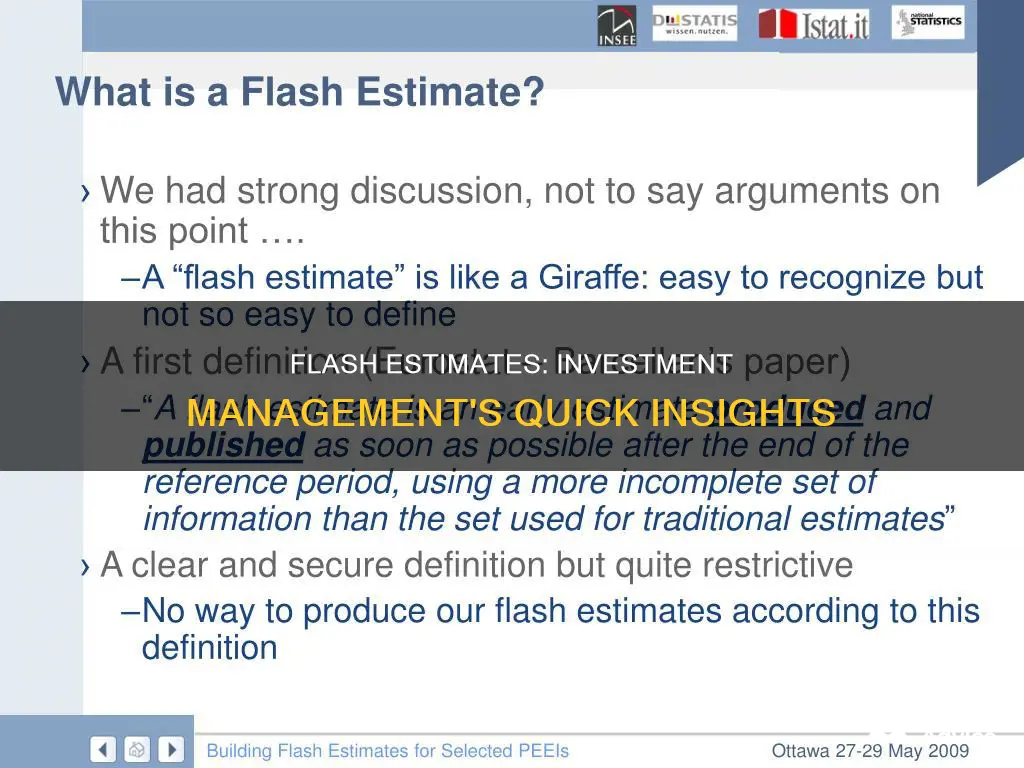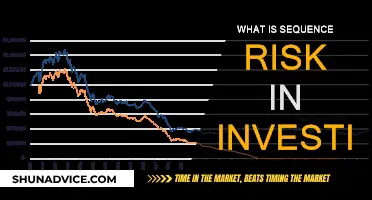
A flash estimate is an early estimate of an economic variable of interest over a recent reference period. It is calculated using a statistical or econometric model and is based on a large but incomplete set of information. Flash estimates are produced using the same methodology as traditional estimates, but with the help of statistical techniques to adjust for the incomplete observations. In investment management, flash estimates are used to get an early gauge of economic activity and make informed decisions. For example, a flash manufacturing PMI provides an estimate of a country's manufacturing sector and can indicate improving or deteriorating economic conditions. Flash estimates are released earlier than traditional estimates, making them a leading indicator of economic trends.
| Characteristics | Values |
|---|---|
| Definition | An early estimate of an economic variable of interest over the most recent reference period |
| Basis | Statistical or econometric model |
| Release date | Earlier than the first release date of the actual data for that variable |
| Calculation | Likely uses a more incomplete set of information than traditional estimates, but uses the same methodology |
| Use case | Manufacturing PMI, tracking a company's key performance indicators and operational figures |
What You'll Learn
- Flash estimates are calculated using statistical/econometric models
- Flash estimates are an early indicator of economic variables
- Flash estimates are based on incomplete information
- Flash reports are a summary of a company's key performance indicators
- Flash reports are used to make informed business decisions

Flash estimates are calculated using statistical/econometric models
Flash estimates are an important tool in investment management, providing an early indication of economic variables of interest. They are calculated using statistical or econometric models, filling in any gaps in data with statistical techniques. This allows investors to make more timely decisions and react to changing economic conditions.
A notable example of a flash estimate is the Flash Manufacturing PMI, which is an estimate of a country's manufacturing sector, based on about 85-90% of total Purchasing Managers' Index (PMI) survey responses each month. This estimate provides an early indication of the final PMI data, which is a leading indicator of the health of the manufacturing sector. The flash estimate is calculated using the same methodology as the regular PMI but with a smaller sample size.
Flash estimates are particularly useful in the fast-paced world of stock trading, where computerized trading platforms and algorithms have increased the speed and volume of transactions. Flash estimates provide almost real-time price information, which can be used to make rapid investment decisions.
In addition to the overall economy, flash estimates can also be applied at a company level, in the form of flash reports. These are periodic snapshots of a company's key performance indicators and operational figures, allowing senior management to make informed decisions and identify any issues before they become significant problems. Flash reports can be customized to include the most relevant metrics for a specific company or industry, such as billable hours for a law firm or machine utilization rates for a manufacturer.
Overall, flash estimates calculated using statistical or econometric models provide investors and managers with timely information to make more proactive decisions. They are a valuable tool for staying ahead in the dynamic world of investment management.
Building an Investment Portfolio: The ETF Way
You may want to see also

Flash estimates are an early indicator of economic variables
In investment management, a flash estimate is an early estimate of an economic variable of interest over the most recent reference period. It is calculated based on a statistical or econometric model and is released earlier than the actual data for that variable. While flash estimates may be calculated using a more incomplete set of information than traditional estimates, they employ the same methodology and can be adjusted using statistical techniques.
Flash estimates are particularly relevant in the context of manufacturing PMI (Purchasing Managers' Index). PMI is a forward-looking estimate of a country's manufacturing sector, based on survey responses from purchasing managers. The flash reading of PMI is typically based on about 85-90% of total survey responses and is intended to provide an accurate advance indication of the final PMI data.
Because flash estimates are released earlier than traditional estimates, they can have a significant impact on markets, especially the foreign exchange market. They are considered a leading indicator, providing evidence of changing economic conditions ahead of comparable government statistics. Any reading above 50 indicates improving conditions, while readings below 50 suggest a deteriorating economic climate.
In addition to manufacturing PMI, flash estimates can be applied to various other areas of a business, including liquidity, productivity, and profitability. For example, a flash report on liquidity would provide information on a company's cash flow, accounts receivable turnover, and operating cash flow. Similarly, a productivity flash report would include operational metrics such as utilization rate, overtime hours, sales growth, and throughput. By regularly reviewing flash reports, management can gain valuable insights into the company's performance and make data-driven decisions.
Retirement Planning: 401(k)s and Investment Portfolios: What's the Connection?
You may want to see also

Flash estimates are based on incomplete information
Flash estimates are preliminary figures that provide an early indication of an economic variable of interest, such as manufacturing performance or price information. They are calculated based on a statistical or econometric model and are typically released before the actual data for the variable becomes available. While flash estimates are designed to offer timely insights, they are based on incomplete information.
In the context of investment management, flash estimates are often derived from a partial set of data, usually about 85% to 90% of the total survey responses or available information. For example, a flash manufacturing PMI (Purchasing Managers' Index) is calculated using a high percentage of the total PMI survey responses, providing an early estimate of a country's manufacturing sector performance.
The use of incomplete information in flash estimates introduces a level of uncertainty and potential inaccuracy. Statistical techniques are employed to adjust for the temporary incomplete observations, but the estimates may still deviate from the final, complete data. This incompleteness is a trade-off for the timeliness of the information, as flash estimates are intended to provide early insights that can guide decision-making.
The nature of flash estimates, with their rapid release and reliance on partial data, means that they can be prone to errors and may not capture the full complexity of economic variables. However, they serve as valuable leading indicators, particularly in the absence of more comprehensive data. Flash estimates are especially useful for identifying emerging trends and potential issues, allowing investors and businesses to make more timely and proactive decisions.
Despite their limitations, flash estimates are widely used in investment management and economic analysis due to their ability to provide a quick snapshot of the current economic landscape. They are considered a useful tool for staying ahead of the curve and making data-driven choices, even with the understanding that the information may be subject to revisions as more comprehensive data becomes available.
FactSet for Portfolio Management: Strategies and Benefits
You may want to see also

Flash reports are a summary of a company's key performance indicators
In investment management, a flash estimate is an early estimate of an economic variable of interest over a recent reference period. It is calculated using a statistical or econometric model and is based on a large but incomplete set of information. Flash estimates are produced using the same methodology as traditional estimates, but with the help of statistical techniques to adjust for the incomplete observations.
The three main sections of a flash report are liquidity, productivity, and profitability. The liquidity section provides information on the company's cash flow, including metrics such as the quick ratio, accounts receivable turnover, and operating cash flow. The productivity section varies depending on the industry but typically includes operational metrics such as utilization rate, overtime hours, sales growth, and throughput. The profitability section covers important financial metrics such as revenue, gross profit margin, operating income, and net profit margin.
Flash reports offer a rough performance measure and are designed to provide timely information to managers. They can be customized to include industry-specific metrics and are particularly useful during seasonal peaks or when a company is undergoing changes. While they may not always be 100% accurate, they help identify trends and exceptions that may require corrective action.
In summary, flash reports are a valuable tool for businesses to monitor their performance, identify irregularities, and make proactive decisions. They provide a concise and timely snapshot of key performance indicators, allowing companies to stay agile and responsive to market changes.
Understanding Investment Portfolios: The Role of Equity
You may want to see also

Flash reports are used to make informed business decisions
In investment management, a flash estimate is an early estimate of an economic variable of interest, calculated using a statistical or econometric model. It is based on a large but incomplete set of information, which is adjusted using statistical techniques. Flash estimates are released earlier than traditional estimates, providing a timely indication of the state of an economy.
In business, flash reports are used to make informed decisions. They are periodic summaries of a company's key performance indicators and operational figures. These reports are usually concise, taking less than an hour to prepare and rarely exceeding one page. They are distributed weekly or monthly and are tailored to the company's specific requirements. Senior management can use these reports to make proactive decisions and identify operational issues before they become significant problems.
Flash reports are divided into three main categories: liquidity, productivity, and profitability. The liquidity section provides an overview of the company's cash flow, including metrics such as the quick ratio, accounts receivable turnover, and operating cash flow. The productivity section varies depending on the industry but typically includes operational metrics such as utilization rates, overtime hours, sales growth, and throughput. The profitability section covers financial metrics such as revenue, gross profit margin, operating income, and net profit margin, which are critical for a business's success.
Comparative flash reports are particularly useful for identifying trends and exceptions. They allow managers to compare current numbers with previous periods, such as the previous week, the same week in the previous year, or budgeted amounts. This information is valuable for lenders and investors, especially when a company is in a period of significant change or if management has previously fallen short of growth and profitability projections.
Overall, flash reports provide a timely snapshot of a company's financial health, enabling managers to make informed, proactive decisions and take corrective action when needed.
Savings vs Investments: Where Should Your Money Go?
You may want to see also
Frequently asked questions
A flash estimate is an early estimate of an economic variable of interest over the most recent reference period. It is calculated using a statistical or econometric model and is usually based on a more incomplete set of information than traditional estimates.
The purpose of a flash estimate is to provide an early indication of the final data for an economic variable. It is produced using the same methodology as regular estimates, but with a release date that is significantly earlier.
A flash estimate is typically calculated using a more incomplete set of information than traditional estimates, but it is produced using the same methodology. Statistical techniques are used to adjust for the temporary incomplete observations.
Examples of flash estimates include the Flash Manufacturing PMI, which provides an early estimate of a country's manufacturing sector, and flash reports, which provide a periodic snapshot of a company's key performance indicators and operational figures.







